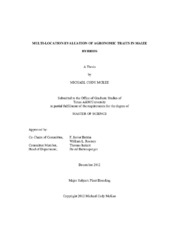| dc.description.abstract | Maize (Zea mays L.) is one of the main crops grown in the United States. Genetic improvement over the last century has seen a shift from using open-pollinated varieties to single cross hybrids. This has resulted in major grain yield gains and improved management methodologies. However, there is still concern about reduced genetic diversity in elite corn germplasm and the potential effects this could have on future maize productivity in the presence of numerous abiotic and biotic pressures. One solution to this issue is the incorporation of exotic germplasm into existing maize improvement programs. This exotic material must be evaluated and characterized because too much or poorly matched exotic material can lead to reduced productivity. The use of multiple environments representative to the target improvement area is the best way to determine the true potential of certain material. The objectives of this research were to: i) estimate the responses of hybrids to aflatoxin and their agronomic performance across a range of environments under inoculation with Aspergillus flavus; ii) identify the hybrids within each group that exhibit the lowest levels of contamination; iii) analyze the relationship between agronomic performance and aflatoxin accumulation; and iv) determine how Genotype x Environment interactions affect these traits.
Agronomic data was collected in ten Texas environments in 2005 for hybrids created from yellow, white, and Quality Protein Maize material that was crossed with one of two elite temperate inbred testers, LH195 or LH210. Response to aflatoxin was measured in eight of these environments. U.S. commercial hybrids were used as checks. Significant differences between hybrids were observed at different environments for different traits. Overall the experimental hybrids had lower aflatoxin accumulation than the commercial checks. They also yielded lower and had lower test weights and 1000 kernel weights. However, there were some hybrids that were competitive with the commercial checks for these agronomic traits. The incorporation of this material into established U.S. lines could be beneficial with regards to aflatoxin accumulation and kernel quality, which could ultimately translate to higher yields and crop quality. | en |


